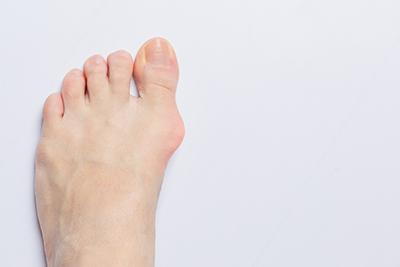What Are Bunions and How Can They Be Treated?

- posted: Dec. 01, 2022
If you have a hard, bony lump on the side of your big toe, it’s probably a bunion. Bunions are caused by a genetic bone deformity which makes your big toe joint protrude outward. Bunions are one of the most common problems seen by a podiatrist.
Bunions are much more common in women, because women often wear narrow shoes with a pointed toe. This type of shoe forces the toes to crush together, which can accelerate the growth of a bunion. High-heeled shoes make the problem worse by forcing the toes forward.
Bunions can make it difficult and painful to wear shoes, and to stand and walk around. If you have a small bunion, there are a few easy remedies you can try which may offer some relief. You can:
- Place inserts inside your shoes to cushion the bunion
- Tape the bunion area to provide support for the bunion
- Take over-the-counter anti-inflammatory and pain medication as needed
If your bunion is larger and painful, you should visit your podiatrist. Your podiatrist may request x-rays to determine the level of bone involvement. If there is not substantial bone involvement, your podiatrist may recommend non-invasive treatments like these:
- Removing corns and calluses to reduce friction
- Custom orthotics or splints to properly realign your toe and foot
- Physical therapy to help you regain flexibility and mobility
For bunions with substantial bone involvement, your podiatrist may recommend surgery to remove the bunion, known as a bunionectomy. The purpose of surgery is to realign your toe and foot.
A large, painful bunion can interfere with your ability to stay active and enjoy your life. You don’t have to put up with bunion pain. Your podiatrist can get rid of your bunion and help you and your feet feel better. To find out more about bunions, bunion surgery, and other podiatry services, call your podiatrist today.

- posted: Dec. 01, 2022
If you have a hard, bony lump on the side of your big toe, it’s probably a bunion. Bunions are caused by a genetic bone deformity which makes your big toe joint protrude outward. Bunions are one of the most common problems seen by a podiatrist.
Bunions are much more common in women, because women often wear narrow shoes with a pointed toe. This type of shoe forces the toes to crush together, which can accelerate the growth of a bunion. High-heeled shoes make the problem worse by forcing the toes forward.
Bunions can make it difficult and painful to wear shoes, and to stand and walk around. If you have a small bunion, there are a few easy remedies you can try which may offer some relief. You can:
- Place inserts inside your shoes to cushion the bunion
- Tape the bunion area to provide support for the bunion
- Take over-the-counter anti-inflammatory and pain medication as needed
If your bunion is larger and painful, you should visit your podiatrist. Your podiatrist may request x-rays to determine the level of bone involvement. If there is not substantial bone involvement, your podiatrist may recommend non-invasive treatments like these:
- Removing corns and calluses to reduce friction
- Custom orthotics or splints to properly realign your toe and foot
- Physical therapy to help you regain flexibility and mobility
For bunions with substantial bone involvement, your podiatrist may recommend surgery to remove the bunion, known as a bunionectomy. The purpose of surgery is to realign your toe and foot.
A large, painful bunion can interfere with your ability to stay active and enjoy your life. You don’t have to put up with bunion pain. Your podiatrist can get rid of your bunion and help you and your feet feel better. To find out more about bunions, bunion surgery, and other podiatry services, call your podiatrist today.
